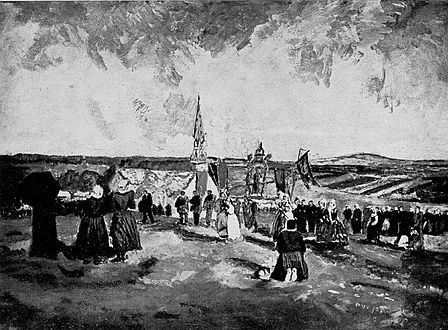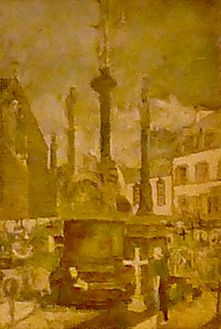Max Jacob facts for kids
Quick facts for kids
Max Jacob
|
|
|---|---|

Max Jacob in 1934
|
|
| Born | 12 July 1876 Quimper, Finistère, Brittany, France |
| Died | 5 March 1944 (aged 67) Drancy Deportation Camp, France |
| Pen name | Léon David Morven le Gaëlique |
| Signature | |

Max Jacob (pronounced maks zha-KOB; born July 12, 1876 – died March 5, 1944) was a French poet, painter, writer, and critic. He was known for his unique style and his friendships with many famous artists of his time.
Contents
Early Life and Artistic Journey
Max Jacob grew up in Quimper, a town in Brittany, France. He later moved to Paris to study at the Paris Colonial School. However, he left in 1897 to follow his passion for art and writing.
In Paris, Max Jacob became good friends with many important artists. He was one of the first people Pablo Picasso met in the city. They became friends in 1901, and Jacob helped Picasso learn French. They even shared a room for a while. Picasso remained a close friend throughout Jacob's life.
Jacob also introduced Picasso to other artists like Guillaume Apollinaire and Georges Braque. He became close with Jean Cocteau, Jean Hugo, Christopher Wood, and Amedeo Modigliani. Modigliani even painted Jacob's portrait in 1916. Jacob also encouraged Jean Moulin, who later became a famous leader in the French Resistance during World War II. Many believe Moulin's secret name, "Max," was chosen in honor of Jacob.
His Unique Style and Beliefs
Max Jacob, who was Jewish, became a Catholic in 1909 after saying he had a special vision. This was an important moment in his life.
He is seen as a key link between two art movements: the Symbolists and the surrealists. Symbolists focused on ideas and emotions, while Surrealists explored dreams and the unconscious mind. You can see Jacob's unique style in his prose poems, like Le cornet à dés (The Dice Box), published in 1917. His paintings were also shown in New York City in the 1930s.
Some of his other writings include the novel Saint Matorel (1911) and the free verse collection Le laboratoire central (1921). He also wrote La défense de Tartuffe (1919), where he shared his thoughts on philosophy and religion. The famous thinker Jacques Lacan once quoted Jacob, saying, "The truth is always new."
His Final Days
In May 1936, Max Jacob moved away from Paris to live in Saint-Benoît-sur-Loire. Sadly, on February 24, 1944, he was arrested by the Gestapo, the secret police of Nazi Germany. He was taken to a prison in Orléans.
Because he was Jewish, Jacob and his family were targeted during World War II. His brother Gaston and sister Myrthe-Lea had already been sent to the Auschwitz concentration camp. Max Jacob was then moved to the Drancy internment camp. From there, he was supposed to be sent to Auschwitz as well.
However, Max Jacob became very ill with pneumonia. He died on March 5, 1944, in the camp's medical area.
After the war, his body was first buried in Ivry. In 1949, his artist friends Jean Cassou and René Iché moved his remains to the cemetery in Saint-Benoît-sur-Loire. René Iché also created the sculpture for his tomb.
Other Names He Used
Besides his birth name, Max Jacob also used other names for his work. These were called pseudonyms. He was known as Léon David and Morven le Gaëlique.
Gallery
See also
 In Spanish: Max Jacob para niños
In Spanish: Max Jacob para niños
- Lionel Floch
- Furniture music: A type of music by Erik Satie was played during one of Jacob's comedies in 1920.
- The Selected Poems of Max Jacob, translated by William Kulik (Oberlin College Press, 1999)
- Monsieur Max (2007), a French TV movie about Jacob's life.





